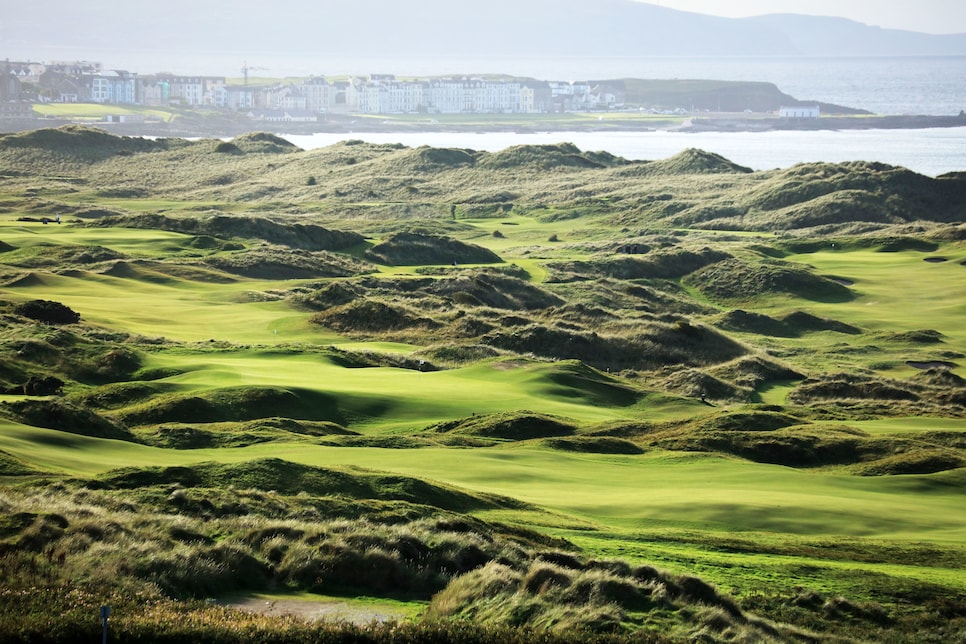The mural takes liberties with the weather. No golden sun cast that orange glow over Royal Portrush’s emerald fairways and azure sea during the final round in 2019—that Sunday delivered the sort of punishing 35-mph winds and relentless rain you’d expect in this corner of the world. Yet the artist’s sun-drenched interpretation captures something truer than meteorological accuracy: The spirit and joy that poured from Shane Lowry and the crowd when he hoisted the claret jug. An idealised sky to speak to what this Open Championship represents, and why it resonates so deeply here.
The mural dominates the landscape for anyone visiting the Open this week—sprawling across a two-story house that sits squarely between the course and the cramped town square, impossible to ignore. But this isn’t merely a tribute to Lowry’s victory but a monument to something far more enduring. Professional tournaments are fleeting spectacles, but Open golf—links golf, the people’s game—is eternal.
Lowry knows this. He tried to demur his thoughts on it—”I’m happy I have to drive the other way” he joked on Monday”—only to acknowledge the gravity of those paint strokes. “I didn’t know what to make of it at the start, and then when they did it, yeah … then people kept sending me pictures. Everyone keeps sending me pictures. Everyone that comes up here sends me pictures standing beside it.
“Some of them I can’t say what they were doing in it,” he added to laughter, “but it is very special. I’ve done something special in my life.”
If we have any quarrel with the mural, it’s that Lowry stands alone. Portrush proper is home to barely 6,000 souls, yet the R&A expects over a quarter-million pilgrims this week. The mathematics should spell chaos, but when an entire community vibrates at the same frequency—when everyone wants to be here—logistics become footnotes. It just works.
You don’t need a mural to grasp what this championship and game mean here. American golf tournaments have morphed into sanitised social events where actual golf feels incidental, authentic fans priced out by corporate hospitality and curiosity seekers drawn by spectacle rather than sport. Other destinations have forged their own golf identities: Pinehurst trades on resort elegance and USGA partnerships, Carmel caters to the wealthy elite, while Bandon has manufactured itself into a pilgrimage site for the devoted. These places wear golf as one facet of their carefully curated brands.

David Cannon
That’s acceptable enough, but it’s surface-level, for these manufactured golf destinations cannot replicate something so fundamentally woven into the fabric of existence. In the United Kingdom, golf retains its democratic soul—it’s the lifeblood of entire communities, the foundation upon which lives are built. Towns breathe the game, golf dictating daily life not as a commercial enterprise but as an inheritance passed through generations. No murals will celebrate J.J. Spaun in Oakmont or immortalise Scottie Scheffler’s exploits at Quail Hollow. There was artwork erected artwork this spring honouring Augusta National’s black caddies, but it was relegated to the historically segregated Sand Hills neighbourhood—a telling reminder of the racial and economic chasms that still fracture American golf. Here, Lowry’s mural sits in plain sight, belonging to everyone who passes by.
Some of this charm lies with links golf itself. Links golf strips away all pretence, testing not just a player’s technical skill but their emotional and spiritual fortitude. The ground game reigns supreme—shots must be shaped and sculpted rather than simply struck, each approach demanding knowledge of wind and firm turf and supported by the lost art of the bump-and-run.
The courses themselves become co-conspirators, their pot bunkers and rolling terrain punishing the proud while rewarding the humble. This is golf’s ultimate crucible, where pretence dissolves in the salt air and only authentic skill survives. It can be mercilessly unfair, beholden to the weather’s whims and the ground’s unpredictable bounces—a capriciousness that makes some dismiss it as mere chance, failing to recognise that this very volatility is precisely its beauty. Links golf doesn’t coddle, it confronts, forcing players to abandon their comfort zones and embrace that mastery comes not from controlling nature, but from learning to confront and work with and survive it.
But mostly, the charm evoked by the mural is the background of links golf, which is suspended from time. This is just the third time the Open has visited this small seaside village, yet the only difference is a few more visitors. Links and life merge without fanfare: fairways bleed into village squares, first tees emerge from behind bus stops, flagsticks salute passing fishermen. Duck into any pub and you’ll discover half the day’s field has beaten you there, scorecards scattered across tables like campaign maps, pints marking the coordinates where dreams were seized or surrendered. The past pulses in the present, the game perpetually renewed, because transcendent things never age, obstinate in their authenticity. Not flawless—nothing touched by human hands achieves perfection—but links golf offers the purest distillation we possess.
It’s the heart of the mural’s message and has nothing to do with the trophy on the line this week: If golf is your religion, this is your heaven.
A public parking lot hugs the coast in Portrush, separated from the beach by a narrow strip of green. Monday night, after storms surrendered to unexpected sunshine, a handful of kids began pitching 30-yard shots back and forth across the grass. One attendant started toward them with concern, but his colleague raised a hand. “Let ’em be,” came the quiet wisdom.
It’s just a mural. But the finest art doesn’t imitate life—it reveals it.
Follow Golf Digest Middle East on social media
Main Image: ANDY BUCHANAN









